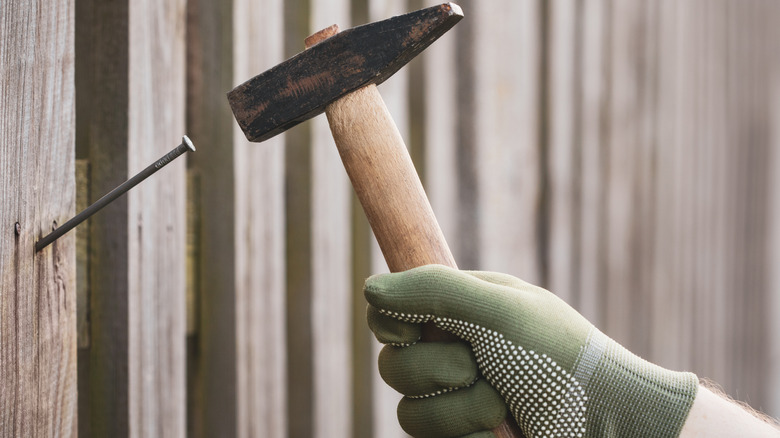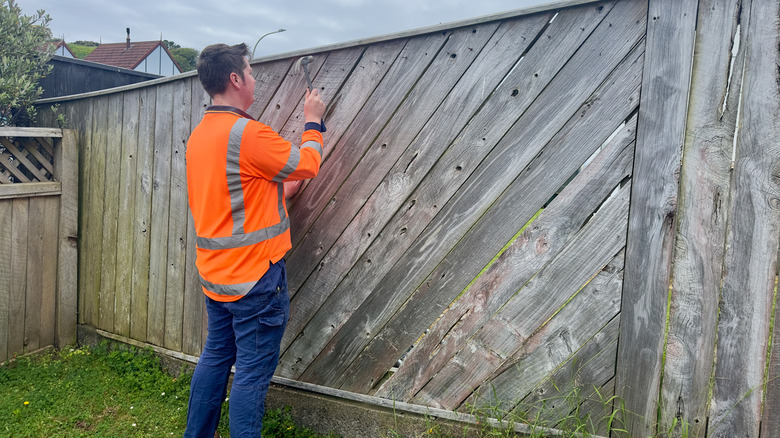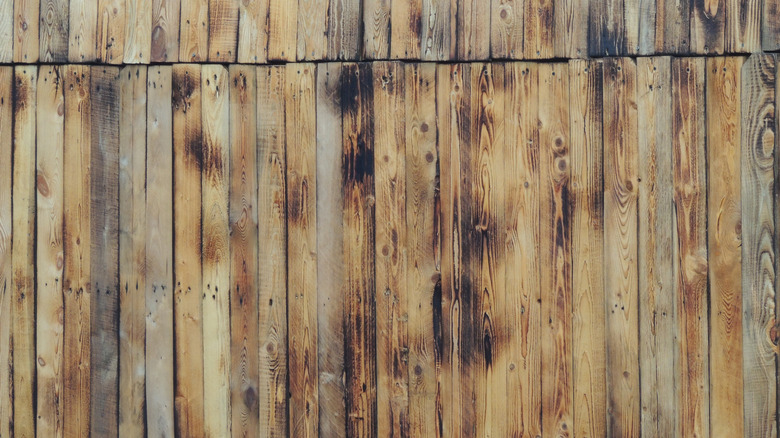Don't Use The Wrong Nails On Your Wood Fence. Here's What Could Happen If You Do
We may receive a commission on purchases made from links.
Installing a gorgeous wood fence requires work. You must read through building codes and regulations, examine your soil's condition, make measurement calls, and check with your neighbors. Unsurprisingly, many homeowners get lost in these details and end up glossing over the critical decision of nail selection. After all, nails are just nails, right? Simple things meant to hold the fence together — what could possibly go wrong? Plenty of things, as it turns out, and to bring you up to speed on the specifics, here's the exclusive scoop from House Digest's Expert Carpenter and Remodeler Bob Beacham.
Given enough time, wooden fences show signs of aging and elemental damage through warping, cracking, and graying. Sometimes, however, they begin bleeding black around their nails section, alluding to things other than age being at play. "The marks are caused by a chemical called tannin. It attacks the iron in steel nails. The streaks are effectively rust," explains Beacham. Tannin is a natural compound found in all wooden planks. "But levels are high in cedar and redwood that are often used for fencing," elaborates Beacham, "Oak also has high tannin." Generally, tannins pose no problem. It's only when the wood gets wet (from rain, dew, or poor handling of the hose) that tannins convert into tannic acid. If you've used ferrous or steel nails, the acid reacts with the iron, marking the area in bluish-black stains. That's why choosing the right nails is important.
Nails you should be using on your wood fence
Even if you're following wooden fence maintenance tips for keeping it pristine year-round, a single nail selection mistake when installing a fence could cost you dear. Beacham explains in House Digest's exclusive interview that, in addition to the black streaks, you risk losing your fence altogether. "The tannin corrodes the nails — eats into them. It will take a while, but eventually, the fence will start to fall apart." This begs the question: what kind of nails skirt such consequences? "Galvanized (zinc-coated) nails are probably the most common and affordable solution," says Beacham. "The zinc protects the steel. They're what I would use." However, he says if you're willing to pay more, hot-dipped galvanized nails, like Metabo HPT's 2-inch Siding Nails, are a superior option since they're more durable.
That being said, Beacham admits that galvanized nails corrode, too. However, he believes it isn't a significant issue because these nails usually last as long as the wood. But in case you don't want to risk corrosion, he recommends using stainless steel ones. He elaborates, "Stainless steel nails are the best (but more expensive). They aren't coated like galvanized nails; they're made by mixing chromium with steel, so the material is the same all the way through." At the same time, he cautions against the relatively less expensive aluminum options. "Aluminum is sometimes suggested, but the nails aren't as strong."
Treating black streaks and replacing plain steel nails
While it's nice to know your options, what do you do when the wooden planks in your fence are already suffering a stained existence? Hint: Pressure washing, sanding, or cleaning with bleach aren't going to be any help. In fact, to remove marks and stains from your fence, the star ingredient to look for is oxalic acid — though white vinegar may come in for the clutch as well, according to Beacham's exclusive quotes to House Digest. "Oxalic acid or white vinegar mixed 50/50 with water (preferably warm) should do the trick." Note that oxalic acid is a toxic substance capable of burning skin on direct contact. So, you must wear protective gloves and goggles should you choose to walk down this route. Also, this solution may not always work, particularly when your fence is past saving. Alternatively, Beacham recommends experimenting with commercial tannin removers.
That being said, is replacing the wrong nails an option? "As far as replacing the nails (is concerned), it's a good idea but might prove difficult," says our remodeling expert. The reason? "If they've been in the fence a long time, they've probably been weakened by the tannin. They could break easily, leaving part in the wood." That's why he proposes prying the posts or panels apart first. Follow up by knocking out the nails backward as opposed to pulling them out. This will ensure you get the entire nail out and replace it with more appropriate options.


